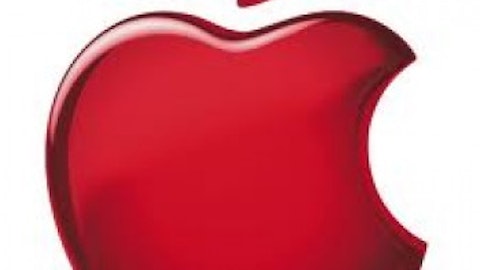Apple Inc. (NASDAQ:AAPL) sold the two most popular phones in the world last quarter. The iPhone 5 and the older 4S model both outsold the next closest competitor, Samsung Electronics Co., Ltd. (KRX:005935)’s Galaxy S3. Apple bears often pose the argument that Samsung is winning market share, and Apple can’t compete abroad in developing countries where the majority of smartphone growth will come from in the future.
Many analysts expect Apple to release a low-end phone, and adopt a similar model to Samsung in emerging markets. I believe this strategy moves away from Apple’s core competencies and won’t generate the boost in profits investors are looking for.
How important are smartphones?
Most investors are aware that the majority of Apple’s profits come from iPhone sales. While the company has a diverse product portfolio, the fantastic growth in the company’s recent years is almost entirely attributable to the popularity of the iPhone. Last quarter, the iPhone accounted for 56% of net sales for the company.
What many investors don’t realize is that Samsung, even with its huge product portfolio and diverse business segments, is just as much tied to the smartphone market as Apple. In fact, the company generated 62% of profits from mobile phones last quarter, and Barclays expects that number to increase to 70% this quarter with the release of the S4. These numbers are very similar to Apple’s.
Unlike Apple Inc. (NASDAQ:AAPL), however, Samsung sells both high-end and mid-to-low-end phones, which perform very well abroad where phone subsidies are rarer than in the United States. Because the biggest growth opportunities are abroad, where cheaper phones are in high demand, sell-side analysts are shouting for an inexpensive iPhone model.
What about margins?
Apple is a high-end company. Even its “cheap” iPad mini sells for 40% gross margin. A low-end iPhone would be quite a shift for the company. A phone priced in the $200-$300 range (unsubsidized) will likely cannibalize premium iPhone sales, and put a damper on margins. Not to mention the impact it could have on its premium-quality image.
The low-end phone market is much more competitive than the high-end, which results in significant margin pressure. Samsung relies on the sales of its high-end phones, like the Galaxy S4, to subsidize its low-end portfolio. Adnaan Ahmad, an analyst at Berenberg Bank, estimates that Samsung’s profit margin on low-end phones could be as low as 1%.
Effectively, Samsung finds itself in the same boat as Apple Inc. (NASDAQ:AAPL) despite a large portfolio of low-end phones. Because profit margins are so low on such phones, a low-end offering from Apple doesn’t appear to be the best solution to Apple’s problems.
A better solution
Most telecom companies in the U.S. work out deals with phone manufacturers to subsidize the price of phones by locking customers in to expensive monthly contracts. Looking abroad, especially in developing areas of Asia, that business model is the exception rather than the rule.
China Mobile Ltd. (ADR) (NYSE:CHL), China’s largest mobile phone service provider with 700 million customers, is one of those exceptions. It’s leading the way in developing a 4G network, which bodes well for the high-end smartphone market in China. What’s more, it recently signed a deal with Nokia to bring its Lumia 920T to customers with a subsidized plan that lowers the price to virtually free.
Apple ought to secure a similar contract, as the company is already in talks with China Mobile to bring the iPhone 6 (or 5S) to the company and capitalize on its expanding 4G network. Subsidized iPhones clearly sell. iPhone sales in the United States, where the minimum price is now $0 (with a contract), are starting to eat away at Google Inc (NASDAQ:GOOG)’s dominance.
If Apple can achieve price parity with China Mobile Ltd. (ADR) (NYSE:CHL) subsidies, a similar effect seems very likely. While Android may currently account for nearly three-quarters of China’s mobile phone market, many come from low-end local manufacturers. A subsidized iPhone looks much more attractive than a cheap low-end or mid-range Android phone.
In fact, similar contracts with China Telecom and China Unicom led to Apple’s best product launch in China yet when it launched the iPhone 5 in December. While many stood in line at Apple stores for the unsubsidized phone, many more flocked to China Telecom and China Unicom stores to snatch up the phone for less than $100 (compared to $850). As a result, Apple sold over 2 million phones on launch weekend.
Stick to what it does best
Many analysts expect Apple Inc. (NASDAQ:AAPL) to release a low-cost iPhone as early as this summer to compete with Samsung and other Android phone makers. While this might move the stock price up in the short term, I don’t think it will have a significant positive impact on profits. It will likely hurt Apple’s already diminishing profit margin as well as its brand image. Instead, Apple needs to work out a deal with China Mobile Ltd. (ADR) (NYSE:CHL), and stick to its core competencies. A big subsidy contract ought to provide a real catalyst for the stock to climb out of its current rut.
The article Why Apple Doesn’t Need a Low-Cost iPhone originally appeared on Fool.com and is written by Adam Levy.
Copyright © 1995 – 2013 The Motley Fool, LLC. All rights reserved. The Motley Fool has a disclosure policy.






